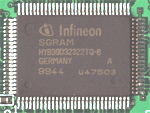The Memory Clock
 Also
benefiting from an increase in clock speed over the GeForce 256 is the memory
pipeline. The DDR GeForce 256 shipped with a 150 MHz DDR memory clock, meaning
that for each clock cycle the DDR RAM can be written to twice, on both the rising
and falling edges of the clock cycle. This 150 MHz DDR memory clock resulted
in a 300 MHz effective memory pipeline (150 MHz x 2 writes per clock = 300 MHz).
Although fast, this 150 MHz DDR speed was still way below the speed for which
the 6 ns Infineon DDR SGRAM chips were rated at (6 ns = 166 MHz). This issue
was fixed with the GeForce 2 GTS which ships with a 333 MHz effective memory
clock (166 MHz DDR) however it still uses the same 6 ns Infineon DDR SGRAM chips.
It remains unknown why the same chip would come shipped at 150 MHz DDR in the
GeForce 256 and 166 MHz DDR in the case of the GeForce 2 GTS, however it is
most likely a limitation imposed by NVIDIA to further separate the 2 product lines.
Also
benefiting from an increase in clock speed over the GeForce 256 is the memory
pipeline. The DDR GeForce 256 shipped with a 150 MHz DDR memory clock, meaning
that for each clock cycle the DDR RAM can be written to twice, on both the rising
and falling edges of the clock cycle. This 150 MHz DDR memory clock resulted
in a 300 MHz effective memory pipeline (150 MHz x 2 writes per clock = 300 MHz).
Although fast, this 150 MHz DDR speed was still way below the speed for which
the 6 ns Infineon DDR SGRAM chips were rated at (6 ns = 166 MHz). This issue
was fixed with the GeForce 2 GTS which ships with a 333 MHz effective memory
clock (166 MHz DDR) however it still uses the same 6 ns Infineon DDR SGRAM chips.
It remains unknown why the same chip would come shipped at 150 MHz DDR in the
GeForce 256 and 166 MHz DDR in the case of the GeForce 2 GTS, however it is
most likely a limitation imposed by NVIDIA to further separate the 2 product lines.
Why is a fast memory clock important? The answer is simpler than it may seem, given a proper explanation. See, the on card memory serves for a place to store information processed by the GPU. The RAM holds frame information until the whole frame is rendered by the GPU and then spits the image out to the monitor. In addition, the on card RAM stores textures that the scene needs to fill in order to complete. The problem facing this method of frame developing is that the video card is only as fast as its slowest part. Although the GPU may be able to spit out data at a rate of x bytes per second, if the data can only get to and from the memory at y bytes per second and y is slower than x then the GPU must 'slow' itself down to accommodate the rate of y bytes per second. If it did not do so then the GPU would be piling information on top of itself and overwhelm the memory bus. The reverse is also true: if the GPU needs data from the RAM then it must travel the slow path to get there.
At low resolutions and colors, this is not a problem. Since a marginal amount of information must travel from the GPU to the memory and vice versa, the memory clock speed allows for plenty of data to be passed. When the resolution is cranked up and the colors turned to 32-bit, the amount of data that must pass to and from the memory increases, creating a bottleneck if the memory can not travel as fast as the GPU. 32-bit color alone doubles the amount of memory bandwidth needed to render a scene. Thus, by increasing the memory clock speed NVIDIA has decreased the bottleneck this system will cause, allowing for major speed increases at high colors and resolutions. This bottleneck produces what is referred to as the effective fill rate because the memory clock is limiting how fast the the GPU can actually go.
Once again, the increased importance of the memory clock due to the increased speed of the GPU plays an important role when considering overclocking.










0 Comments
View All Comments